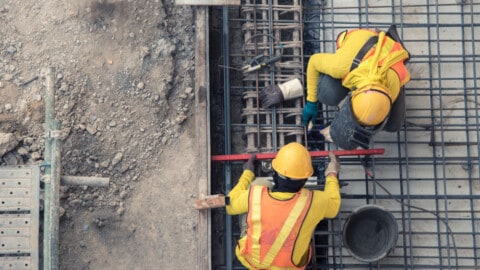The use of dehumidification to prevent corrosion during the blast cleaning and coating of iron and steel bridge structures is an advanced and widely accepted practice in Australia and internationally.
Unless dehumidification is employed during the blasting and coating cycle, the operation may be severely restricted by the appearance of corrosion on the exposed surface before a coating can be applied. In some instances a “rust bloom” has occurred within two hours of the blast, rendering the surface unfit for coating. Often the structure can only be cleaned and coated in sections due to the rapid onset of corrosion; even then, the application of a protective holding primer is required.
Factors which affect corrosion
“Rust blooming” is caused by the chemical reaction of oxygen and moisture in the air with constituents of the metal surface. The added presence of natural or industrial effluent stimulates an even more aggressive attack. It is generally recognised that when the moisture content of the air is low, the onset of corrosion is prevented, therefore the relative humidity is a critical factor. As shown in Figure 1 when relative humidity is less than 60 per cent the rate of corrosion of steel rapidly declines.

Relative humidity varies inversely with air temperature, because of this characteristic it may appear that the introduction of sensible heat into the space would serve to maintain safe relative humidity levels and prevent the onset of corrosion. This is not often the case.
Air in contact with the treated metal surface can be affected by the temperature of the metal, creating high relative humidity levels, or even precipitation (condensation) of free water due to the “dewpoint” being reached. To overcome this problem enough heat energy must be imparted to the metal to ensure the air temperature is not decreased. This is generally impractical and uneconomical.
Corrosion prevention by humidity control involves the continuous extraction of moisture from the air to maintain low relative humidity levels. This function may be performed by either a desiccant or refrigeration type dehumidifier.
The operation characteristics of the dehumidifier must include the capacity to maintain satisfactory conditions within the seal blasting space despite seasonal weather variations. Refrigeration type dehumidifiers operate well in warm weather, but as ambient temperature decreases they become less efficient, until at or below freezing point, performance is severely impacted. This type of dehumidifier can only be employed when ambient dewpoint temperatures are high.
Corrosion prevention by Munters dehumidifiers
Munters’ desiccant-based dehumidifiers are impervious to climatic variations and will perform effectively under almost any conditions. In practice, the dehumidifier usually maintains 50 per cent RH in the centre of the space, which relates to a safe 60 per cent RH at the metal surfaces.

As a result, the aforementioned holding primer is unnecessary and clean surfaces may be left exposed without rust blooming for extended periods. In some cases, Munters dehumidifiers have “held the blast” for up to fourteen days. Many of Australia’s leading blast and coat contractors rely on Munters equipment to ensure success of their remediation projects.
The unique configuration of Munters rotating desiccant wheel as shown in Figure 2, ensures smooth, trouble free and efficient dehumidification of blast and coated structures. Munters dehumidifiers are used extensively for grit blasting operations of fuel or chemical tanks, water storage tanks, marine oil bunkers, naval vessels, iron and steel bridges, and many other steel structures. Available in capacities ranging from as little as 100m3/h to a massive 20,000m3/h, Munters also operates a convenient Rental Solutions Service, providing dehumidifiers on a short-term or long-term project basis.
This partner content is brought to you by Munters. For more information, visit https://www.munters.com/en/areas-of-expertise/painting/.




















Gained lots of knowledge from this article.Corrosion is very dangerous problem in metals.It should be cured in the initial stage only .Otherwise maintenance charges are so high.Nice to know about preventing the corrosion by dehumidification. Thanks for sharing this informative article.
Jasmine, Please feel free to visit our web address http://www.munters.com you will find further information there.
Regards
Paul Roberts
Director Global Services -APAC
Wow you provided something interesting and new too, this was really nice reading your blog it is very interesting and 9informative too. I must say that the writer’s writing skills are really appreciable. Thank you for sharing this with us.